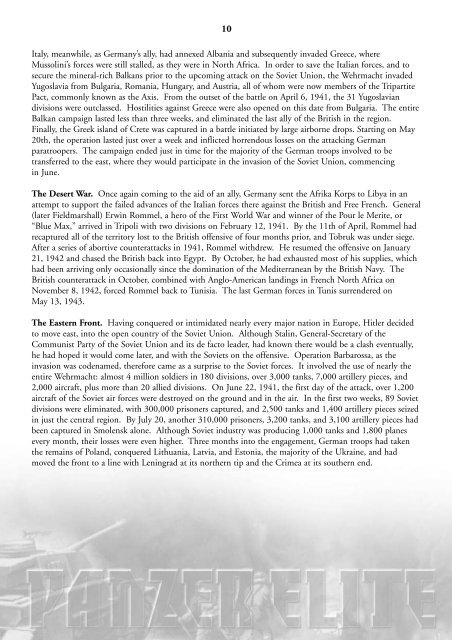The Art Of Tank Warfare - Chris Keeling
The Art Of Tank Warfare - Chris Keeling
The Art Of Tank Warfare - Chris Keeling
Create successful ePaper yourself
Turn your PDF publications into a flip-book with our unique Google optimized e-Paper software.
10<br />
Italy, meanwhile, as Germany’s ally, had annexed Albania and subsequently invaded Greece, where<br />
Mussolini’s forces were still stalled, as they were in North Africa. In order to save the Italian forces, and to<br />
secure the mineral-rich Balkans prior to the upcoming attack on the Soviet Union, the Wehrmacht invaded<br />
Yugoslavia from Bulgaria, Romania, Hungary, and Austria, all of whom were now members of the Tripartite<br />
Pact, commonly known as the Axis. From the outset of the battle on April 6, 1941, the 31 Yugoslavian<br />
divisions were outclassed. Hostilities against Greece were also opened on this date from Bulgaria. <strong>The</strong> entire<br />
Balkan campaign lasted less than three weeks, and eliminated the last ally of the British in the region.<br />
Finally, the Greek island of Crete was captured in a battle initiated by large airborne drops. Starting on May<br />
20th, the operation lasted just over a week and inflicted horrendous losses on the attacking German<br />
paratroopers. <strong>The</strong> campaign ended just in time for the majority of the German troops involved to be<br />
transferred to the east, where they would participate in the invasion of the Soviet Union, commencing<br />
in June.<br />
<strong>The</strong> Desert War. Once again coming to the aid of an ally, Germany sent the Afrika Korps to Libya in an<br />
attempt to support the failed advances of the Italian forces there against the British and Free French. General<br />
(later Fieldmarshall) Erwin Rommel, a hero of the First World War and winner of the Pour le Merite, or<br />
“Blue Max,” arrived in Tripoli with two divisions on February 12, 1941. By the 11th of April, Rommel had<br />
recaptured all of the territory lost to the British offensive of four months prior, and Tobruk was under siege.<br />
After a series of abortive counterattacks in 1941, Rommel withdrew. He resumed the offensive on January<br />
21, 1942 and chased the British back into Egypt. By October, he had exhausted most of his supplies, which<br />
had been arriving only occasionally since the domination of the Mediterranean by the British Navy. <strong>The</strong><br />
British counterattack in October, combined with Anglo-American landings in French North Africa on<br />
November 8, 1942, forced Rommel back to Tunisia. <strong>The</strong> last German forces in Tunis surrendered on<br />
May 13, 1943.<br />
<strong>The</strong> Eastern Front. Having conquered or intimidated nearly every major nation in Europe, Hitler decided<br />
to move east, into the open country of the Soviet Union. Although Stalin, General-Secretary of the<br />
Communist Party of the Soviet Union and its de facto leader, had known there would be a clash eventually,<br />
he had hoped it would come later, and with the Soviets on the offensive. Operation Barbarossa, as the<br />
invasion was codenamed, therefore came as a surprise to the Soviet forces. It involved the use of nearly the<br />
entire Wehrmacht: almost 4 million soldiers in 180 divisions, over 3,000 tanks, 7,000 artillery pieces, and<br />
2,000 aircraft, plus more than 20 allied divisions. On June 22, 1941, the first day of the attack, over 1,200<br />
aircraft of the Soviet air forces were destroyed on the ground and in the air. In the first two weeks, 89 Soviet<br />
divisions were eliminated, with 300,000 prisoners captured, and 2,500 tanks and 1,400 artillery pieces seized<br />
in just the central region. By July 20, another 310,000 prisoners, 3,200 tanks, and 3,100 artillery pieces had<br />
been captured in Smolensk alone. Although Soviet industry was producing 1,000 tanks and 1,800 planes<br />
every month, their losses were even higher. Three months into the engagement, German troops had taken<br />
the remains of Poland, conquered Lithuania, Latvia, and Estonia, the majority of the Ukraine, and had<br />
moved the front to a line with Leningrad at its northern tip and the Crimea at its southern end.


